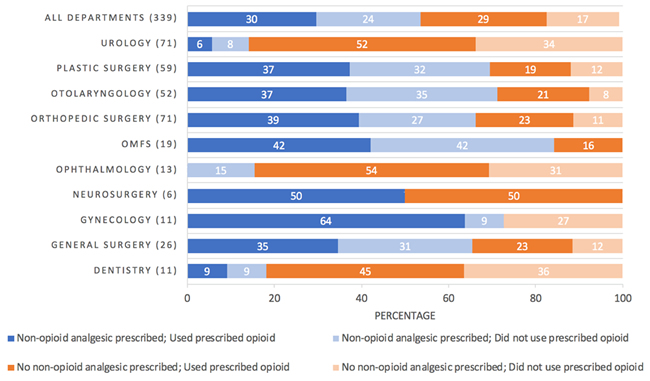Assessment of Opioid and Non-Opioid Analgesic Prescriptions after Pediatric Ambulatory Surgery
Nhi N. Ho, BA; Anjali Dixit, MD, MPH; Christina M. Inglis-Arkell, MD; and Solmaz P. Manuel, MD
Department of Anesthesia and Perioperative Care
University of California San Francisco
San Francisco, California
Submitted by Nhi N. Ho, BA
Introduction
Opioid exposure in the postoperative period poses risks of misuse, chronic use, and adverse events in the pediatric population.1,2 Evidence from the past two decades shows that accidental overdoses, hospitalizations, and unintentional deaths attributed to opioids in the pediatric population have risen between 160-200%.3 A risk factor for initiation of opioids and development of subsequent opioid use disorder is surgery. One important strategy to lower these risks in the pediatric population is to minimize unnecessary opioid exposure and maximize use of multimodal non-opioid pain medications in the postoperative period. We therefore assessed opioid and non-opioid analgesic prescribing patterns across surgical subspecialties in our pediatric ambulatory surgical population to evaluate for opportunities to optimize discharge regimens.
Methods
We conducted a telephone survey and electronic medical record review evaluating postoperative opioid prescription, non-opioid analgesic prescription, and opioid use. From April through December 2017, all patients aged 1-21 years who underwent ambulatory surgery at our hospital received an automated call on the first business day after discharge asking:
- Question 1:
Were you prescribed opioids for post-operative pain control? - Question 2:
If yes, are you currently taking them? For patients who answered “yes” to question 1, we searched discharge instructions and orders for non-opioid analgesic prescriptions or written instructions for use of non-opioid analgesics (NSAIDs, acetaminophen, gabapentin, lidocaine, and triptans).
Results
Of the 1,705 pediatric patients that underwent ambulatory surgery, 1075 (63.0%) responded to the survey. Of those, 339 (31.5%) reported being prescribed opioids. Of the 339 patients prescribed opioids, 200 (58.5%) reported taking opioids at the time of the survey. Only 99 (53.5%) received prescriptions and/or discharge orders to take non-opioid analgesics as an alternative to opioids. Of patients who received and reported using their opioid prescriptions, only 57 (28.5%) were provided with non-opioid analgesic alternatives. When broken down by surgical subspecialty (Figure 1), ophthalmologic, urologic, neurosurgical, and dental patients had the highest rates of using opioids while not being prescribed non-opioid alternatives (53.9%, 52.1%, 50%, and 45.5% respectively).

Figure 1: Non-Opioid Analgesic Prescriptions by Post-Operative Opioid Use and Surgical Sub-Specialty
Conclusions
Opioid prescribing and unused opioid prescriptions were prevalent in our hospital’s pediatric ambulatory surgical population. Patients who used opioids often did not receive prescriptions or instructions to use non-opioid analgesic alternatives. There was marked variability in prescribing patterns of opioids and non-opioid analgesics across surgical subspecialties. These findings highlight an opportunity to educate prescribers and patients on minimizing opioids and optimizing discharge regimens with a more multi-modal analgesic approach.
References
- Harbaugh CM, Lee JS, Hu HM, et al. Persistent Opioid Use Among Pediatric Patients After Surgery. Pediatrics. 2018;141(1):e20172439. doi:10.1542/peds.2017-2439
- Allen JD, Casavant MJ, Spiller HA, Chounthirath T, Hodges NL, Smith GA. Prescription Opioid Exposures Among Children and Adolescents in the United States: 2000-2015. Pediatrics. 2017;139(4):e20163382. doi:10.1542/peds.2016-3382
- Gaither JR, Leventhal JM, Ryan SA, Camenga DR. National trends in hospitalizations for opioid poisonings among children and adolescents, 1997 to 2012. JAMA Pediatr. 2016;170(12):1195-1201. doi:10.1001/jamapediatrics.2016.2154




